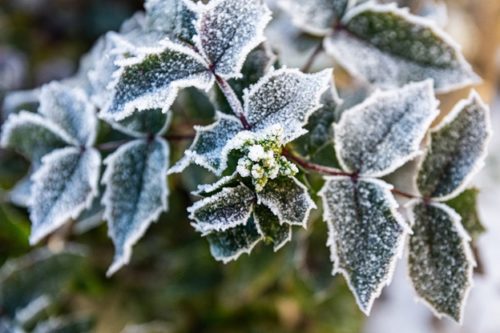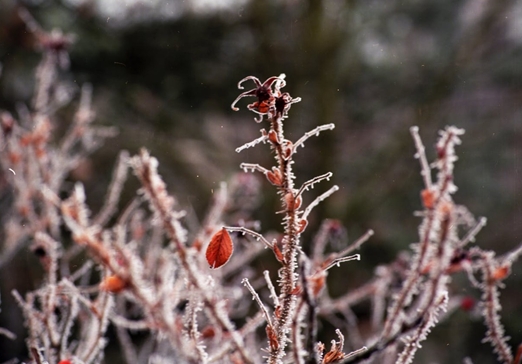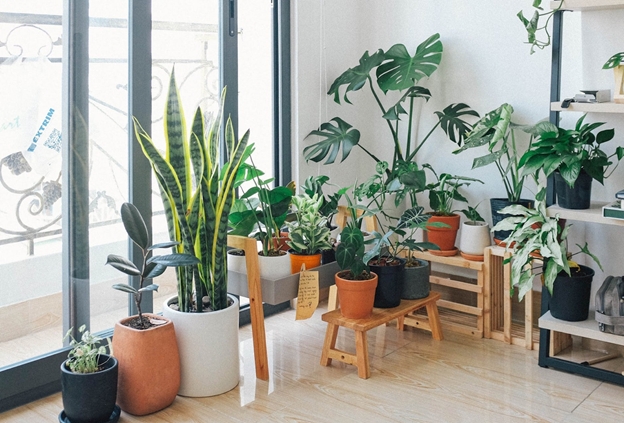Cold temperatures and sudden frost can harm plants, flowers and trees. Here is everything you need to know about how to protect plants from the cold.
Plants are resilient. They can survive outdoors in normal conditions without much help. However, the weather seems to be getting more extreme these days. This means an unexpected frost could come along and quickly destroy your garden. A cold snap in early spring or autumn could be devastating to the plants in your care.
So what is a gardener to do? This article will dive into what frost is, which plants are most affected, and how to protect plants from the cold.
What is Frost?
From the National Geographic Society, frost is water vapor, or water in gas form, that becomes solid. Frost usually forms on objects like cars, windows, and plants outside in air saturated or filled with moisture.
You might think that frost occurs at the freezing point of water, 32℉ or 0℃, but frost actually occurs a few degrees about 32℉, up to 36℉. Frost will hurt your plants because the water in the plant’s cells turns solid, disrupts fluid movement, and damages the plant’s tissues.
When To Expect Frost
According to The Old Farmer’s Almanac, there are two types of frost:
- A Light Frost: when the nighttime temperature drops to at or just below 32℉ or 0℃
- A Hard Freeze: a period of at least four consecutive hours of air temperatures that are below 28℉ or -2℃
Many plants can survive a light frost, but very few can survive a hard freeze. This is important to remember because temperature and time in the cold can be the difference between life and death with your plants.
The easiest way to predict the weather is to let the weatherman do it for you. Meteorologists will usually comment on Frost Advisory, Freeze Watch, Freeze Warning, and Hard Freeze Warning.
If you don’t trust your local weather personality, here are five quick tips on how to tell if frost is coming your way:
- Warm during the day – If the day was quite warm, chances are slimmer for a night frost.
- Cloudy in the evening – Clouds help stave off frost. The thicker, the better.
- Wind – Wind will also reduce the risk of frost.
- Dew point – If more moisture is in the air, the less likely a frost will come.
- Slope – If your garden or home is at the bottom of a hill, less wind and cold air sinking will reduce the moisture surrounding it, increasing the chances of frost.
Which Plants Need the Most Protection From the Cold?
In general, veggies and herbs that harvest in midsummer and annual flowers with their brightest colours usually need the most protection from frost. Any plant that fruits or flowers in warm temperatures are going to be more susceptible to the cold. If your plants are only found naturally in tropical climates, they will need protection as they have not developed defenses naturally.
On the other hand, perennials, which come back year after year, are better suited to handle a sudden temperature change, as long as they are abundant in your area.
In addition, some edible plants actually taste better with a frost on them. Vegetables such as onions, radish, cabbage, peas, broccoli, lettuce, and cauliflower do well with a slight dip in the mercury (around 26℉). Other veggies such as beets, Brussels sprouts, spinach, kale, parsley, carrots and collards can survive in even lower temperatures (around the low 20’s).
How To Protect Plants From the Cold
Frost can be deadly for your plants, but with some diligence and a few simple actions, you can protect your plants from the cold. Here are some easy and actionable tips to get the most out of your plants and keep them safe in winter:
-
Bring Potted Plants Indoors:
This is the easiest and most effective way to protect plants from the cold. Potted plants and hanging baskets do not have the added benefit of being insulated in the earth and are therefore the most susceptible to frost damage. If you can lift your potted plants or hanging baskets, you can move them from the harsh temperatures outside to warmer temperatures inside a garage or shed. Moving them inside your warm house could shock them. Also, keep them isolated from your houseplants to prevent the spread of insects.
-
Cover Outdoor Plants With a Sheet:
For plants in the ground, covering them with a cloth, blanket, or sheet can protect them from a light frost. Do not use plastic, as it will damage the plants. You can put plastic over the blanket, but there must be a cloth barrier between the plants and the plastic. Remember to remove the sheet or blanket in the morning, so condensation doesn’t pool up and refreeze.
-
Water Plants in the Afternoon:
It may seem contradictory, but moisture helps protect plants from the cold. Moisture insulates the plants. Watering them midday when the temperature is still warm will help protect them at night when it’s cold.
4.Use a Cloche:
A cloche is like a bell that goes over the top of plants to insulate them. It acts as a mini greenhouse. An easy way to make a cloche is to cut the bottom out of a milk jug. Then cover the plant with it. Next push it an inch into the soil, and tie it to a stake to keep it from blowing away. Keep the lid on at night and remove it when it gets warm again.
5.Add Mulch:
Like putting on a sweater when it gets cold, adding a layer of much will add a layer of insulation for your plants when the temperature drops. Useful mulch types include straw, leaf mold, wood chips, or even a pile of leaves from your yard. You’ll want to have a reasonably thick layer of mulch (3 to 6 inches) but also leave an inch or two opening around the stalk to allow the warmth and moisture to travel through the plant.
6.Wrap in Burlap:
Wrapping larger plants and trees in burlap can provide an excellent layer of protection. Pound some stakes into the ground around the plant and wrap the burlap around the stakes, so the plant appears fenced in. You could also fill up the space with hay or leaves for extra protection.
7.Simulated Air Flow:
Farmers sometimes use helicopters to simulate wind to keep their crops from freezing. While this is not practical for gardeners, the principle is sound. You can use a fan or blower to simulate wind for your garden to protect plants from the cold.
Make sure you remove these frost protectors when the weather warms back up. If your plants do get damaged or killed from cold temperatures you’ll know if the leaves turn black or brown. Wait until the weather warms up and there is no additional risk of frost before pruning.
Final Thoughts On Cold Weather and Plants
The fall and spring can bring unexpected drops in temperatures. These temps can harm or kill the plants you have been working so hard to keep alive and grow. With these simple tips and tricks to protect your plants from cold, you can weather a cold snap. In turn you keep your plants alive and keep your garden coming back bigger and better each year.
Garden upkeep and doing all these tasks to keep your plants protected from the cold can be daunting. If you need more ideas to beautify your yard, help with protecting your plants from the cold or any other lawn care services such as mulching, pruning, leaf removal and more, the professionals at Turf Managers will take care of everything without you having to lift a finger.
Contact us today to experience The Turf Managers Difference.
Check Out Our Services Offered





